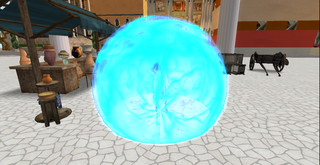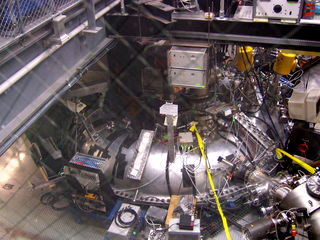Related Research Articles

A fusor is a device that uses an electric field to heat ions to a temperature at which they undergo nuclear fusion. The machine induces a potential difference between two metal cages, inside a vacuum. Positive ions fall down this voltage drop, building up speed. If they collide in the center, they can fuse. This is one kind of an inertial electrostatic confinement device – a branch of fusion research.

Brookhaven National Laboratory (BNL) is a United States Department of Energy national laboratory located in Upton, New York, a hamlet of the Town of Brookhaven. It was formally established in 1947 at the site of Camp Upton, a former U.S. Army base on Long Island. Located approximately 60 miles east of New York City, it is managed by Stony Brook University and Battelle Memorial Institute.

A linear particle accelerator is a type of particle accelerator that accelerates charged subatomic particles or ions to a high speed by subjecting them to a series of oscillating electric potentials along a linear beamline. The principles for such machines were proposed by Gustav Ising in 1924, while the first machine that worked was constructed by Rolf Widerøe in 1928 at the RWTH Aachen University. Linacs have many applications: they generate X-rays and high energy electrons for medicinal purposes in radiation therapy, serve as particle injectors for higher-energy accelerators, and are used directly to achieve the highest kinetic energy for light particles for particle physics.

In speculative fiction, a force field, sometimes known as an energy shield, force shield, energy bubble, or deflector shield, is a barrier produced by something like energy, negative energy, dark energy, electromagnetic fields, gravitational fields, electric fields, quantum fields, telekinetic fields, plasma, particles, radiation, solid light, magic, or pure force. It protects a person, area, or object from attacks or intrusions, or even deflects energy attacks back at the attacker. This fictional technology is created as a field of energy without matter that acts as a wall, so that objects affected by the particular force relating to the field are unable to pass through the field and reach the other side, instead being deflected or destroyed. Actual research in the 21st century has looked into the potential to deflect radiation or cosmic rays, as well as more extensive shielding.
Ultra-high vacuum is the vacuum regime characterised by pressures lower than about 1×10−6 pascals. UHV conditions are created by pumping the gas out of a UHV chamber. At these low pressures the mean free path of a gas molecule is greater than approximately 40 km, so the gas is in free molecular flow, and gas molecules will collide with the chamber walls many times before colliding with each other. Almost all molecular interactions therefore take place on various surfaces in the chamber.
Plasma stealth is a proposed process to use ionized gas (plasma) to reduce the radar cross-section (RCS) of an aircraft. Interactions between electromagnetic radiation and ionized gas have been extensively studied for many purposes, including concealing aircraft from radar as stealth technology. Various methods might plausibly be able to form a layer or cloud of plasma around a vehicle to deflect or absorb radar, from simpler electrostatic or radio frequency discharges to more complex laser discharges. It is theoretically possible to reduce RCS in this way, but it may be very difficult to do so in practice. Some Russian missiles e.g. the 3M22 Zircon (SS-N-33) and Kh-47M2 Kinzhal missiles have been reported to make use of plasma stealth.

Aneutronic fusion is any form of fusion power in which very little of the energy released is carried by neutrons. While the lowest-threshold nuclear fusion reactions release up to 80% of their energy in the form of neutrons, aneutronic reactions release energy in the form of charged particles, typically protons or alpha particles. Successful aneutronic fusion would greatly reduce problems associated with neutron radiation such as damaging ionizing radiation, neutron activation, reactor maintenance, and requirements for biological shielding, remote handling and safety.
Plasma acceleration is a technique for accelerating charged particles, such as electrons or ions, using the electric field associated with electron plasma wave or other high-gradient plasma structures. These plasma acceleration structures are created using either ultra-short laser pulses or energetic particle beams that are matched to the plasma parameters. The technique offers a way to build affordable and compact particle accelerators.

The Madison Symmetric Torus (MST) is a reversed field pinch (RFP) physics experiment with applications to both fusion energy research and astrophysical plasmas.

The AWAKE facility at CERN is a proof-of-principle experiment, which investigates wakefield plasma acceleration using a proton bunch as a driver, a world-wide first. It aims to accelerate a low-energy witness bunch of electrons from 15 to 20 MeV to several GeV over a short distance by creating a high acceleration gradient of several GV/m. Particle accelerators currently in use, like CERN's LHC, use standard or superconductive RF-cavities for acceleration, but they are limited to an acceleration gradient in the order of 100 MV/m.

The Cosmotron was a particle accelerator, specifically a proton synchrotron, at Brookhaven National Laboratory. Its construction was approved by the U.S. Atomic Energy Commission in 1948, reaching its full energy in 1953, and continuing to run until 1966. It was dismantled in 1969.
The National Synchrotron Light Source (NSLS) at Brookhaven National Laboratory (BNL) in Upton, New York was a national user research facility funded by the U.S. Department of Energy (DOE). Built from 1978 through 1984, and officially shut down on September 30, 2014, the NSLS was considered a second-generation synchrotron.

A particle accelerator is a machine that uses electromagnetic fields to propel charged particles to very high speeds and energies to contain them in well-defined beams. Small accelerators are used for fundamental research in particle physics. Accelerators are also used as synchrotron light sources for the study of condensed matter physics. Smaller particle accelerators are used in a wide variety of applications, including particle therapy for oncological purposes, radioisotope production for medical diagnostics, ion implanters for the manufacture of semiconductors, and accelerator mass spectrometers for measurements of rare isotopes such as radiocarbon.
The IEEE Marie Sklodowska-Curie Award is a Technical Field Award that was established by the IEEE Board of Directors in 2008. This award may be presented for outstanding contributions to the field of nuclear and plasma sciences and engineering. This award may be presented to an individual, individuals on a team, or up to three multiple recipients. Recipients of this award receive a bronze medal, certificate, and honorarium. This award was presented for the first time in 2011.
An energy recovery linac (ERL) is a type of linear particle accelerator that provides a beam of electrons used to produce x-rays by synchrotron radiation. First proposed in 1965 the idea gained interest since the early 2000s.
Ady Hershcovitch is a plasma physicist best known for his 1995 invention, the plasma window, which was later patented.. In the plasma window, a plasma separates air from a vacuum by preventing the air from rushing into the vacuum. This scientific development can facilitate non-vacuum ion material modification, manufacturing of superalloys, and high-quality non-vacuum electron-beam welding. The device has been compared to the force field in the Star Trek TV series. He is well known for his work in plasma physics at Brookhaven National Laboratory. He has over 80 publications and 15 patents.
The Accelerator Test Facility (BNL-ATF) is a user facility within the Brookhaven National Laboratory (BNL) in New York, USA, as part of the Science Accelerator Stewardship. Commencing operation in 1992, the BNL-ATF carries out research and development in collaboration with other labs around the world on advanced accelerator physics and studies the interactions of high-power electromagnetic radiation and high-brightness electron beams, including plasma-acceleration and laser-acceleration of electrons.
Heavy ion fusion is a fusion energy concept that uses a stream of high-energy ions from a particle accelerator to rapidly heat and compress a small pellet of fusion fuel. It is a subclass of the larger inertial confinement fusion (ICF) approach, replacing the more typical laser systems with an accelerator.

Ilan Ben-Zvi is an accelerator physicist and academic. He was the associate chair for accelerator R&D at the Collider-Accelerator Department (C-AD), and is a distinguished scientist emeritus at the Collider-Accelerator Department (C-AD) at Brookhaven National Laboratory.
James Benjamin Rosenzweig is a experimental plasma physicist and a distinguished professor at the University of California, Los Angeles (UCLA). In the field of plasma wakefield acceleration, he is regarded as the father of the non-linear "blowout" interaction regime, where a laser beam, when fired into a plasma at intense levels, expels electrons from the plasma and creates a spherical structure that can effectively focus and accelerate the plasma.
References
- ↑ Shiga, David (2006-07-17). "Plasma bubble could protect astronauts on Mars trip". New Scientist . Retrieved 2008-04-02.
- ↑ "Hot mettle". Newscientist.com. Retrieved 2015-05-04.
- ↑ "Plasma Window Technology for Propagating Particle Beams and Radiation from Vacuum to Atmosphere". Nasa Tech Briefs. 1998-05-01. Retrieved 2008-04-02.
- ↑ Kaku, Michio (2008-03-14). "Physics of the Impossible: A Scientific Exploration into the World of Phasers, Force Fields, Teleportation, and Time Travel". The Wall Street Journal . Retrieved 2008-04-02.
- ↑ "Hot mettle". New Scientist. 2003-04-12. Retrieved 2008-04-02.
- ↑ "United States Patent: 5578831:Hershcovitch (November 26, 1996) Method and apparatus for charged particle propagation". Patft.uspto.gov. Retrieved 2016-03-01.
- ↑ "United States Patent: 6528948:Hershcovitch (March 4, 2003) Plasma valve". Patft.uspto.gov. Retrieved 2016-03-01.
- ↑ "Students prove real-life Star Wars deflector shield is possible - ExtremeTech".
- ↑ Alyssa Newcomb (March 23, 2015). "Boeing Patents 'Star Wars'-Style Force Field Technology". ABC News. Retrieved March 23, 2015.
- ↑ "Boeing Has Patented a Plasma 'Force Field' to Protect Against Shock Waves". 30 March 2015.
- ↑ "Creating Force Fields. A simple idea. Nearly impossible ... | by Ella Alderson | Predict | Medium". 4 October 2020.
- ↑ "'Physics of the Impossible: A Scientific Exploration into the World of Phasers, Force Fields, Teleportation, and Time Travel' - WSJ".
- ↑ "StarTram2010: Maglev Launch: Ultra Low Cost Ultra High Volume Access to Space for Cargo and Humans". startram.com. Archived from the original on July 27, 2017. Retrieved April 28, 2011.
- ↑ "BNL Wins R&D 100 Award for 'Plasma Window'" (PDF). Bnl.gov. Retrieved 2015-05-04.
- ↑ "Plasma Window Technology for Propagating Particle Beams and Radiation from Vacuum to Atmosphere – Nasa Tech Briefs :: NASA Tech Briefs". Nasatech.com. 2007-05-15. Retrieved 2015-05-04.